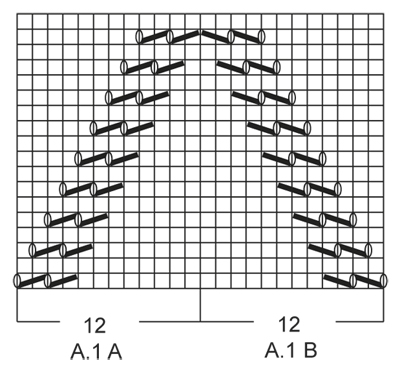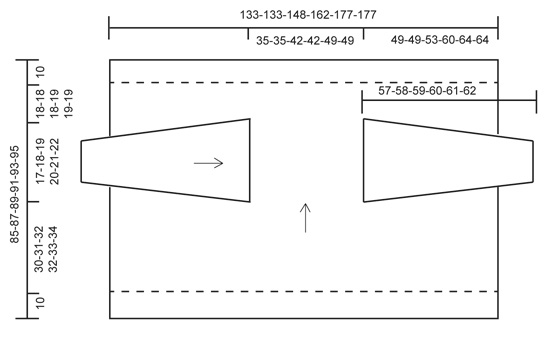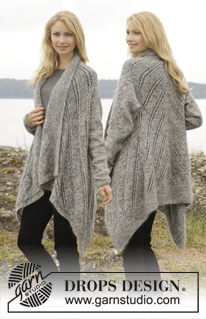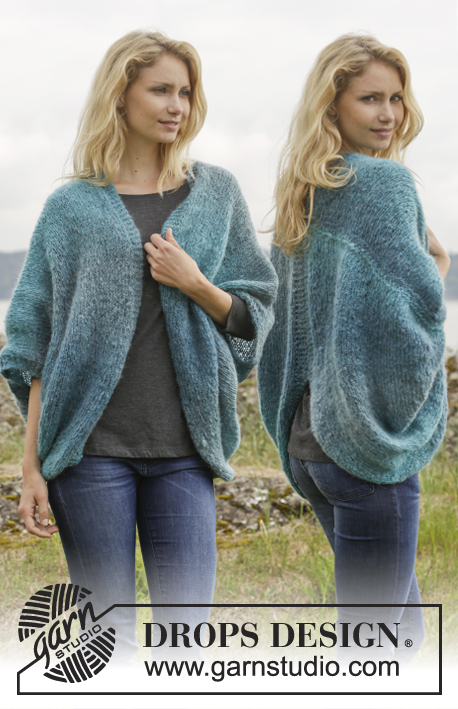Comments / Questions (61)
![]() Isabelle wrote:
Isabelle wrote:
Dans ce modèle on nous dit de commencer un nouveau rang ajouré tous les 20 rangs or le diagramme est sur 18 rangs, que fait on du rang manquant ?
01.03.2024 - 19:20DROPS Design answered:
Bonjour Isabelle, on continue simplement le motif ajouré pour que les diagonales continuent comme avant, mais il faudra 20 rangs pour pouvoir commencer un nouveau motif en largeur. Bon tricot!
04.03.2024 - 07:20
![]() Chey wrote:
Chey wrote:
Bonjour, quand est-ce qu'on arrête de tricoter avec les 2 fils différents comme dit dans la VESTE et pour les MANCHES ? : "VESTE : Monter 228-228-252-276-300-300 m avec l'aiguille circulaire 4 et 1 fil de chaque qualité (= 2 fils tricotés ensemble). " et "MANCHES : [...] Monter 32-35-37-38-39-41 m (y compris 1 m lis de chaque côté) avec l'aiguille circulaire 4 et 1 fil de chaque qualité (= 2 fils tricotés ensemble). "
23.10.2022 - 19:16DROPS Design answered:
Bonjour Mme Chey, cette veste se tricote entièrement avec 1 fil de chacune des deux qualités, autrement dit avec 1 fil Alpaca + 1 fil Kid-Silk et 17 mailles x 22 rangs jersey = 10 x 10 cm. Bon tricot!
24.10.2022 - 08:45
![]() Bouvard Plunet Catherine wrote:
Bouvard Plunet Catherine wrote:
Oui j ai bien compris qu il fallait recréer un dessin mais je ne sais pas à quel moment Merci pour votre réactivité Très cordialement Cath
22.11.2021 - 09:13DROPS Design answered:
Bonjour Mme Bouvard Plunet et désolée pour la réponse tardive, il semble que votre question n'a pas été vue; lorsque vous divisez l'ouvrage en 3 parties, vous continuez les motifs exactement comme avant sur le nombre de mailles restantes pour que les diagonales continue comme elles le faisaient avant et continuez à répéter le motif en hauteur tout comme auparavant également. Bon tricot!
19.01.2022 - 10:44
![]() Bouvard Plunet Catherine wrote:
Bouvard Plunet Catherine wrote:
Bonjour Lorsque le tricot est séparé en 3 morceaux dois je reconstituer le dessin du dos et si oui à quel moment Merci Cordialement Cath
22.11.2021 - 08:14DROPS Design answered:
Bonjour Cath, tout à fait, vous devez continuer le point fantaisie du dos comme avant. La 2ème photo pourra probablement vous éclairer. Bon tricot!
22.11.2021 - 08:49
![]() Louise Linding wrote:
Louise Linding wrote:
Hej Jeg forstår ikke forklaringen - der står at der startes på en ny hulrække for hver 20. Pind, men der er kun 18 pinde i diagrammet? Derudover står der, at 1.hulrække i A.1 starter 4 p før den anden - det forstår jeg heller ikke… Håber i kan hjælpe mig…
24.10.2021 - 17:31DROPS Design answered:
Hej Louise, det vil ske automatisk når du starter det hvor der står JAKKE: Slå op og strik MØNSTER A.1B på første halvdel og A.1A over den anden halvdel. God fornøjelse!
25.10.2021 - 12:27
![]() Rumposch wrote:
Rumposch wrote:
GLEICHZEITIG beginnt in jeder 20. R auf jeder Seite der Arb eine neue Lochreihe d.h. die 1.Lochreihe von A.1 beginnt 4 R vor den anderen.----der Abstand der Reihen stimmt doch dann nicht oder sehe ich das falsch? Danke für Ihre Hilfe. Rumposch
20.04.2021 - 21:22DROPS Design answered:
Liebe Frau Rumposch, ein neues Rapport von A.1 können Sie beginnen wenn Sie wenigstens 8 Maschen + 2 M (für das 1. Lochmuster) + 1 M davor = 11 Maschen vor dem Umschlag im ersten A.1 und nach dem Umschlag von letzen A.2. Bei dieser Reihe können Sie nur 1 Loch stricken im ersten A.1 und letzten A.2, bei der nächsten Hinreihe haben Sie dann genügend Maschen um die beiden Löcher zu stricken. Viel Spaß beim stricken!
21.04.2021 - 07:50
![]() Luiza wrote:
Luiza wrote:
Lindo adorei ,vou fazer um desse pra mim parabéns pra quem criou esse belo trabalho.👏👏❤
13.03.2021 - 04:22
![]() Jackie wrote:
Jackie wrote:
Loved this item but have never knitted from a chart before and am struggling a bit to follow - am I right in saying that by the time I have knitted 44cm I will have reduced my stitches? If so I am unable to see where! Is it possible to get the pattern row by row rather than a chart?
14.02.2021 - 11:18DROPS Design answered:
Dear Jackie, after you cast on and knit the first 44 rows, your number of stitches does not change. In the pattern for ever decrease there is a corresponding yarnover. Unfortunately there is no written out explanation for the pattern itself, but HERE is a lesson, that might help you make sense of the charts. Happy Knitting!
14.02.2021 - 13:30
![]() Nelli wrote:
Nelli wrote:
Ich möchte dieses Modell in Drops Air nacharbeiten, wie viel Gramm bräuchte ich für Gr. XXXL? Danke:)
16.08.2019 - 17:05DROPS Design answered:
Liebe Nelli, Sie können unseren Garnumrechner benutzen, oder hier finden Sie wie man die neue Garnmenge kalkuliert. Viel Spaß beim stricken!
19.08.2019 - 08:37
![]() BOUVARD PLUNET wrote:
BOUVARD PLUNET wrote:
Bonjour j ai bien compris qu il fallait recommencer un nouveau dessin tout les 20 rangs mais je n ai pas assez de mailles pour créer le point fantaisie Merci beaucoup Cath bouvard plunet
07.07.2019 - 08:15DROPS Design answered:
Bonjour Mme Bouvard Plumet, pour répéter les motifs en hauteur, on continue d'abord les diagonales de A.1B et A.1A aux rangs suivants, jusqu'à ce que vous ayez 11 m endroit en début de rang avant le 1er A.1B et après le dernier A.1A, vous pouvez maintenant commencer un nouveau motif en largeur sur ces 11 premières et dernières mailles (= 1 jeté, 1 diminution, 10 m end pour A.1B - 10 m end, 1 jeté, 1 dim pour A.1A) (soit 4 rangs en continuant les diagonales comme avant, avant de pouvoir commencer une nouvelle diagonale ajourée). Bon tricot!
08.07.2019 - 09:58
First in Line#firstinlinecardigan |
|||||||||||||
 |
 |
||||||||||||
Knitted DROPS jacket in garter st with lace pattern in ”Alpaca” and ”Kid-Silk”. Size: S - XXXL.
DROPS 156-25 |
|||||||||||||
|
GARTER ST (back and forth on circular needle): K all rows. 1 ridge = 2 rows K. PATTERN: See diagram A.1. The diagram shows all rows in pattern seen from RS. NOTE: Diagram does not fit vertically when repeated, but continue eyelet rows diagonally upwards as before, AT THE SAME TIME beg a new eyelet row every 20th row in each side of piece. I.e. 1st eyelet row in A.1 beg 4 rows before the other. ---------------------------------------------------------- JACKET: Cast on 228-228-252-276-300-300 sts on circular needle size 4 mm with 1 strand of each yarn (= 2 strands). Work in GARTER ST - see explanation above - for 10 cm. On next row from RS switch to circular needle size 5 mm and work as follows: Work 6 sts in garter st, PATTERN A.1B (= 12 sts) – see explanation above, over the next 108-108-120-132-144-144 sts (= 9-9-10-11-12-12 repetitions in width), A.1A (= 12 sts) over the next 108-108-120-132-144-144 sts (= 9-9-10-11-12-12 repetitions in width), finish with 6 sts in garter st. Diagram A.1 is displaced 1 st towards mid back on every row from RS. REMEMBER THE KNITTING TENSION! Continue this pattern until piece measures 40-41-42-42-43-44 cm. Adjust so that last row is from WS. Work next row as follows - from RS: Work 6 sts in garter st, work pattern as before over the next 72-72-78-90-96-96 sts, garter st over the next 11 sts, pattern as before over the next 50-50-62-62-74-74 sts, garter st over the next 11 sts, pattern as before over the next 72-72-78-90-96-96 sts, finish with 6 sts in garter st. Work like this for 3 rows AT THE SAME TIME on last row cast off the middle st in every 11 sts ridge = 226-226-250-274-298-298 sts. Now divide piece and work opening for armhole. RIGHT FRONT PIECE: Slip the last 143-143-161-173-191-191 sts on a stitch holder, only work over the first 83-83-89-101-107-107 sts. Continue pattern as before, i.e. work as follows from RS: 6 sts in garter st, A.1B as before, finish with 5 sts in garter st. Work until piece measures 17-18-19-20-21-22 cm from where piece was divided. NOTE: Adjust so that last row is from WS. Slip sts on a stitch holder and work left front piece. LEFT FRONT PIECE: Slip the last 83-83-89-101-107-107 sts back on needle, work as right front piece, work A.1A instead of A.1B. NOTE: Adjust so that last row is from WS. Slip sts on 1 stitch holder and work back piece. BACK PIECE: Slip the remaining 60-60-72-72-84-84 sts back on needle. Continue pattern, work the 5 sts in each side in garter st. When back piece measures 17-18-19-20-21-22 cm, adjust so that last row is from WS and adjust according to front piece, slip all parts back on same circular needle size 5 mm. Now work as follows: Work in garter st and pattern as before over front piece until the 5 sts in garter st, work 5 sts in garter st, cast on 1 new st, 5 sts in garter st, pattern over back piece as before until the 5 sts in garter st, work 5 sts in garter st, cast on 1 new st, 5 sts in garter st, pattern and garter st over front piece as before = 228-228-252-276-300-300 sts on needle. Work 2 ridges in total over the 11 sts between each front piece and back piece. Continue with pattern with 6 edge sts in garter st in each side of piece until piece measures 75-77-79-81-83-85 cm in total. Switch to circular needle size 4 mm. Work in garter st. Cast off when piece measures 85-87-89-91-93-95 cm. SLEEVE: Worked back and forth on circular needle. Cast on 32-35-37-38-39-41 sts (incl 1 edge st in each side of piece) on circular needle size 4 mm with 1 strand of each yarn (= 2 strands). Work 4 ridges. Switch to circular needle size 5 mm. Now continue piece in stocking st. When piece measures 9 cm, inc 1 st inside 1 edge st in each side of piece. Repeat inc every 3-3-3-2½-2½-2½ cm 13-13-14-15-16-17 more times = 60-63-67-70-73-77 sts on needle. Work in stocking st until piece measures 52-53-54-55-56-57 cm. Cast off edge st in each side of piece at beg of the next 2 rows = 58-61-65-68-71-75 sts remain on needle. Then cast off for sleeve cap in each side of piece at beg of every row as follows: Cast off 4 sts 5 times in total = 18-21-25-28-31-35 sts remain on row. Cast off the remaining sts. Piece measures approx. 57-58-59-60-61-62 cm. ASSEMBLY: Sew in sleeves. Sew underarm seams inside 1 edge st. |
|||||||||||||
Diagram explanations |
|||||||||||||
|
|||||||||||||

|
|||||||||||||

|
|||||||||||||
Have you finished this pattern?Tag your pictures with #dropspattern #firstinlinecardigan or submit them to the #dropsfan gallery. Do you need help with this pattern?You'll find 20 tutorial videos, a Comments/Questions area and more by visiting the pattern on garnstudio.com. © 1982-2025 DROPS Design A/S. We reserve all rights. This document, including all its sub-sections, has copyrights. Read more about what you can do with our patterns at the bottom of each pattern on our site. |
|||||||||||||

































































Post a comment to pattern DROPS 156-25
We would love to hear what you have to say about this pattern!
If you want to leave a question, please make sure you select the correct category in the form below, to speed up the answering process. Required fields are marked *.